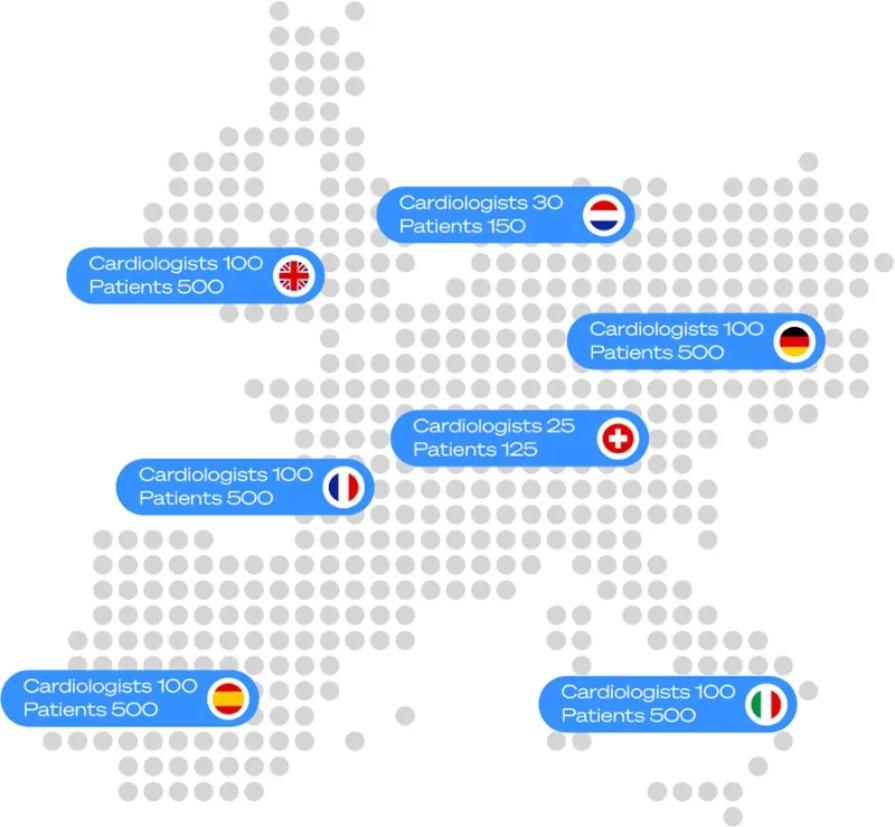ACS Europath Project

Pulse presents ACS EuroPath: a pioneering programme on post-ACS patient pathway optimisation1,2
The ACS EuroPath programme, an initiative brought to you by Pulse, aims to improve patient outcomes by identifying opportunities to optimise the post-ACS patient pathway in current clinical practice and proven solutions to meet these opportunities.1,2
ACS EuroPath: A pioneering EU programme on ACS patient pathway optimisation, aiming to improve patient outcomes since 2018.1,2
1.Involving 555 cardiologists and data collected from 2,775 participating patients around Europe3

2. Assessing current post-ACS lipid management clinical practices1
Data collected from patient record forms during acute phase and follow-up1
1 year of data collection including lipid profile, medications, and follow-up visit planning1
Evaluating ACS lipid management compliance to ESC/EAS guidelines1
3. Identifying pathway models2
8 Verified examples of post-ACS patient pathway solutions to reach LDL-C goal of <55 mg/dL, evaluated and assessed in terms of replicability, from 7 countries2
Hospital Del Mar - Spain
Hospitals in The Netherlands - Netherlands
BEL-FaHST centres - Belgium
Rivoli Hospital - Italy
AKH Hospital - Austria
Skåne University Hospital in Malmő - Sweeden
Besançon Hospital - France
The ACS EuroPath programme identifies opportunities to treat aggressively, combine and start early for ACS patients and provides verified pathway models that were implemented by European Health Centres.1,2*
|
Treat aggressively |
Combine |
 Start Early Start Early |
|
|
ESC/EAS 2019 Guidelines1 |
LDL-C <55 mg/dL (<1.4 mmol/L) AND a ≥50% reduction from baseline |
|
Follow up every 4–6 weeks when not at target |
|
Reality (ACS EuroPath§) |
87% of LDL-tested patients were not at goal at 2nd follow up5 (n=546/626)5 (68% at 2016 LDL-C goal of <70 mg/dL [n=423/626])2,5 |
75% didn’t receive additional treatment when not at LDL-C goal after 1st follow up3 (n=578/774)5 |
64% are not followed up in <6 weeks3 |
|
Verified pathway models† |
3-Month Follow-Up by Cardiologist Netherlands: identification of all very high-risk ACS patients with LDL-C >70 mg/dL to ensure 3-month follow-up algorithm, including LLT intensification protocol with cardiologist2 |
Combination Therapy France: systemise high-intensity statin and ezetimibe prescription to all patients with LDL-C >100 mg/dL, including statin-naive patients2 |
Virtual Visits Spain: virtual visit by cardiologist every 6 weeks with lipid profile monitoring until patients reach LDL-C target2 |
| Discharge Letters Italy: discharge letter for the GP with LDL-C target. Ask for LDL-C test within 1 month. Request to refer the patient to the cardiologist if LDL-C is not at target2 |
Cardiac Rehab LLT Protocol Sweden: cardiac rehabilitation nurses enabled to prescribe additional LLT therapies according to protocol2 |
*By means of a 45-minute online questionnaire, data on 2,775 ACS patients (either acute case or follow-up patients) were collected from 555 cardiologists across 7 European countries (France, Germany, Italy, Spain, United Kingdom, Switzerland and the Netherlands), including data on lipid profile, medications, follow- up visit planning, screening for familial hypercholesterolaemia. The aim of this survey was to evaluate the compliance to current ESC/EAS guidelines during management of ACS and the effectiveness of secondary prevention in post-ACS patients.1
†As a follow-up from the ACS Patient Pathway Project, initiatives from European health centres in- and post-hospital ACS lipid management aimed at overcoming the gaps present in each country2
- Landmesser U, Pirillo A, Farnier M, et al. Lipid-lowering therapy and low-density lipoprotein cholesterol goal achievement in patients with acute coronary syndromes: The ACS patient pathway project. Atheroscler Suppl. 2020;42:e49–e58.
- Alings M, Descamps O, Guillon B, et al. Implementation of clinical practices and pathways optimizing ACS patients lipid management: Focus on eight European initiatives. Atheroscler Suppl. 2020;42:e59–e64.
- Mach F, Baigent C, Catapano AL, et al. 2019 ESC/EAS Guidelines for the management of dyslipidaemias: lipid modification to reduce cardiovascular risk. Eur Heart J. 2020;41(1):111–188.
- Landmesser U, Pirillo A, Fernier M, et al. Lipid-lowering therapy and low-density lipoprotein cholesterol goal achievement in patients with acute coronary syndromes: The ACS patient pathway project. Atheroscler Suppl. Suppl. 2020;42:e49–e58.
- Catapano AL, Graham I, De Backer, G, et al. 2016 ESC/EAS Guidelines for the management of dyslipidaemias. Eur Heart J. 2016;37(39):2999–3058.
- Sionis A, Catapano AL, De Ferrari GM, et al. Improving lipid management in patients with acute coronary syndrome: The ACS Lipid EuroPath tool. Atheroscler Suppl. 2020;42:e65–e71.
ACS= acute coronary syndrome ; ESC European Atheroscleros is Society ; ESC=European Society of Cardiology; LDL-C= low-density lipoprotein cholesterol; PCSK9i= proprotein convertase subtilisin/kexin type 9 inhibitor.


